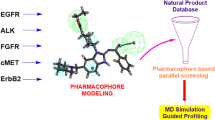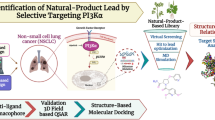Abstract
Lung cancer is the second most common cancer, which is the leading cause of cancer death worldwide. The FDA has approved almost 100 drugs against lung cancer, but it is still not curable as most drugs target a single protein and block a single pathway. In this study, we screened the Drug Bank library against three major proteins- ribosomal protein S6 kinase alpha-6 (6G77), cyclic-dependent protein kinase 2 (1AQ1), and insulin-like growth factor 1 (1K3A) of lung cancer and identified the compound 5-nitroindazole (DB04534) as a multitargeted inhibitor that potentially can treat lung cancer. For the screening, we deployed multisampling algorithms such as HTVS, SP and XP, followed by the MM\GBSA calculation, and the study was extended to molecular fingerprinting analysis, pharmacokinetics prediction, and Molecular Dynamics simulation to understand the complex’s stability. The docking scores against the proteins 6G77, 1AQ1, and 1K3A were − 6.884 kcal/mol, − 7.515 kcal/mol, and − 6.754 kcal/mol, respectively. Also, the compound has shown all the values satisfying the ADMET criteria, and the fingerprint analysis has shown wide similarities and the water WaterMap analysis that helped justify the compound’s suitability. The molecular dynamics of each complex have shown a cumulative deviation of less than 2 Å, which is considered best for the biomolecules, especially for the protein–ligand complexes. The best feature of the identified drug candidate is that it targets multiple proteins that control cell division and growth hormone mediates simultaneously, reducing the burden of the pharmaceutical industry by reducing the resistance chance.







Similar content being viewed by others
References
Organization WH. WHO report on cancer: setting priorities, investing wisely and providing care for all. 2020. https://www.who.int/publications/i/item/9789240001299.
Organization WH. Gender in lung cancer and smoking research. 2004. https://apps.who.int/iris/handle/10665/43086.
Ferlay J, Colombet M, Soerjomataram I, Parkin DM, Piñeros M, Znaor A et al (2021) Cancer statistics for the year 2020: an overview. Int J Cancer 149(4):778–789. https://doi.org/10.1002/ijc.33588
Sharma R (2022) Mapping of global, regional and national incidence, mortality and mortality-to-incidence ratio of lung cancer in 2020 and 2050. Int J Clin Oncol 27(4):665–675. https://doi.org/10.1007/s10147-021-02108-2
Minna JD, Roth JA, Gazdar AF (2002) Focus on lung cancer. Cancer Cell 1(1):49–52. https://doi.org/10.1016/S1535-6108(02)00027-2
Suzuki K, Watanabe S-i, Wakabayashi M, Saji H, Aokage K, Moriya Y et al (2022) A single-arm study of sublobar resection for ground-glass opacity dominant peripheral lung cancer. J Thorac Cardiovasc Surg 163(1):289-301.e2. https://doi.org/10.1016/S1535-6108(02)00027-2
Shaik NA, Al-Kreathy HM, Ajabnoor GM, Verma PK, Banaganapalli B (2019) Molecular designing, virtual screening and docking study of novel curcumin analogue as mutation (S769L and K846R) selective inhibitor for EGFR. Saudi J Biol Sci 26(3):439–448. https://doi.org/10.1016/j.sjbs.2018.05.026
Viktorsson K, Lewensohn R, Zhivotovsky B (2014) Systems biology approaches to develop innovative strategies for lung cancer therapy. Cell Death Dis 5(5):e1260-e. https://doi.org/10.1038/cddis.2014.28
Gazdar A (2009) Activating and resistance mutations of EGFR in non-small-cell lung cancer: role in clinical response to EGFR tyrosine kinase inhibitors. Oncogene 28(1):S24–S31. https://doi.org/10.1038/onc.2009.198
Yarden Y (2001) The EGFR family and its ligands in human cancer: signalling mechanisms and therapeutic opportunities. Eur J Cancer 37:3–8. https://doi.org/10.1016/S0959-8049(01)00230-1
Schraufnagel DE, Balmes JR, Cowl CT, De Matteis S, Jung S-H, Mortimer K et al (2019) Air pollution and noncommunicable diseases: a review by the forum of international respiratory societies’ environmental committee, part 2: Air pollution and organ systems. Chest 155(2):417–426. https://doi.org/10.1016/j.chest.2018.10.041
Wang J, Jiang Y, Liang H, Li P, Xiao H, Ji J et al (2012) Attributable causes of cancer in China. Ann Oncol 23(11):2983–2989. https://doi.org/10.1093/annonc/mds139
Liu T-C, Jin X, Wang Y, Wang K (2017) Role of epidermal growth factor receptor in lung cancer and targeted therapies. Am J Cancer Res 7(2):187
Prabhu VV, Prabhu V (2017) Epidermal growth factor receptor tyrosine kinase: a potential target in treatment of non-small-cell lung carcinoma. J Environ Pathol, Toxicol Oncol. https://doi.org/10.1615/jenvironpatholtoxicoloncol.2017018341
Tan L, Zhang J, Wang Y, Wang X, Wang Y, Zhang Z et al (2022) Development of dual inhibitors targeting epidermal growth factor receptor in cancer therapy. J Med Chem 65(7):5149–5183. https://doi.org/10.1021/acs.jmedchem.1c01714
Jiang W, Cai G, Hu PC, Wang Y (2018) Personalized medicine in non-small cell lung cancer: a review from a pharmacogenomics perspective. Acta Pharm Sin B 8(4):530–538. https://doi.org/10.1016/j.apsb.2018.04.005
Levitzki A, Klein S (2010) Signal transduction therapy of cancer. Mol Aspects Med 31(4):287–329. https://doi.org/10.1016/j.mam.2010.04.001
Facchinetti F, Rossi G, Bria E, Soria J-C, Besse B, Minari R et al (2017) Oncogene addiction in non-small cell lung cancer: focus on ROS1 inhibition. Cancer Treat Rev 55:83–95. https://doi.org/10.1016/j.ctrv.2017.02.010
Lu X, Yu L, Zhang Z, Ren X, Smaill JB, Ding K (2018) Targeting EGFRL858R/T790M and EGFRL858R/T790M/C797S resistance mutations in NSCLC: Current developments in medicinal chemistry. Med Res Rev 38(5):1550–1581. https://doi.org/10.1002/med.21488
Sullivan I, Planchard D (2017) Next-generation EGFR tyrosine kinase inhibitors for treating EGFR-mutant lung cancer beyond first line. Front Med 3:76. https://doi.org/10.3389/fmed.2016.00076
Chrysostomou S, Roy R, Prischi F, Thamlikitkul L, Chapman KL, Mufti U et al (2021) Repurposed floxacins targeting RSK4 prevent chemoresistance and metastasis in lung and bladder cancer. Science Translational Medicine 13(602):eaba4627. https://doi.org/10.1126/scitranslmed.aba4627
Lawrie AM, Noble M, Tunnah P, Brown NR, Johnson LN, Endicott JA (1997) Protein kinase inhibition by staurosporine revealed in details of the molecular interaction with CDK2. Nat Struct Biol 4(10):796–801. https://doi.org/10.1038/nsb1097-796
Favelyukis S, Till JH, Hubbard SR, Miller WT (2001) Structure and autoregulation of the insulin-like growth factor 1 receptor kinase. Nat Struct Biol 8(12):1058–1063. https://doi.org/10.1038/nsb721
Ahmad S, Bano N, Qazi S, Yadav MK, Ahmad N, Raza K (2022) Multitargeted molecular dynamic understanding of butoxypheser against SARS-CoV-2: an in silico study. Nat Prod Commun 17(7):1-934578X221115499. https://doi.org/10.1177/1934578X221115499
Ahmad S, Bhanu P, Kumar J, Pathak RK, Mallick D, Uttarkar A et al (2022) Molecular dynamics simulation and docking analysis of NF-κB protein binding with sulindac acid. Bioinformation 18(3):170–179. https://doi.org/10.6026/97320630018170
Ahmad S, Pasha KM, Raza K, Rafeeq MM, Habib AH, Eswaran M et al (2022) Reporting dinaciclib and theodrenaline as a multitargeted inhibitor against SARS-CoV-2: an in-silico study. J Biomol Struct Dyn. https://doi.org/10.1080/07391102.2022.2060308
Alghamdi YS, Mashraqi MM, Alzamami A, Alturki NA, Ahmad S, Alharthi AA et al (2022) Unveiling the multitargeted potential of N-(4-Aminobutanoyl)-S-(4-methoxybenzyl)-L-cysteinylglycine (NSL-CG) against SARS CoV-2: a virtual screening and molecular dynamics simulation study. J Biomol Struct Dyn. https://doi.org/10.1080/07391102.2022.2110158
Ramlal A, Ahmad S, Kumar L, Khan FN, Chongtham R (2021) From molecules to patients: the clinical applications of biological databases and electronic health records. Translational bioinformatics in healthcare and medicine. Academic Press, London, pp 107–25. https://doi.org/10.1016/B978-0-323-89824-9.00009-4
Yadav MK, Ahmad S, Raza K, Kumar S, Eswaran M, Pasha KMM (2022) Predictive modeling and therapeutic repurposing of natural compounds against the receptor-binding domain of SARS-CoV-2. J Biomol Struct Dyn. https://doi.org/10.1080/07391102.2021.2021993
Schrödinger Release 2023–1: Maestro, Schrödinger, LLC, New York, NY, 2021. https://www.schrodinger.com/citations.
Schrödinger Release 2023–1: Protein preparation wizard; Epik, Schrödinger, LLC, New York, NY, 2021; Impact, Schrödinger, LLC, New York, NY; Prime, Schrödinger, LLC, New York, NY, 2021. 32. Release S. 1: Epik.(2020). Schrödinger Release. 2020;1. https://www.schrodinger.com/citations.
Schrödinger Release 2023–1: Prime, Schrödinger, LLC, New York, NY, 2021. https://www.schrodinger.com/citations.
Lu C, Wu C, Ghoreishi D, Chen W, Wang L, Damm W et al (2021) OPLS4: Improving force field accuracy on challenging regimes of chemical space. J Chem Theor Comput 17(7):4291–4300. https://doi.org/10.1021/acs.jctc.1c00302
Wishart DS, Feunang YD, Guo AC, Lo EJ, Marcu A, Grant JR et al (2018) DrugBank 5.0: a major update to the DrugBank database for 2018. Nucleic Acids Res 46(1):1074–82. https://doi.org/10.1093/nar/gkx1037
Schrödinger Release 2023–1: LigPrep, Schrödinger, LLC, New York, NY, 2021. https://www.schrodinger.com/citations.
Halgren TA, Murphy RB, Friesner RA, Beard HS, Frye LL, Pollard WT et al (2004) Glide: a new approach for rapid, accurate docking and scoring. 2. Enrichment factors in database screening. J Med Chem 47(7):1750–9. https://doi.org/10.1021/jm030644s
Schrödinger Release 2023–1: QikProp, Schrödinger, LLC, New York, NY, 2021. https://www.schrodinger.com/citations.
Targowska-Duda KM, Maj M, Drączkowski P, Budzyńska B, Boguszewska-Czubara A, Wróbel TM et al (2022) WaterMap-guided structure-based virtual screening for acetylcholinesterase inhibitors. ChemMedChem 17(8):e202100721. https://doi.org/10.1002/cmdc.202100721
Schrödinger Release 2023–1: WaterMap, Schrödinger, LLC, New York, NY, 2021. https://www.schrodinger.com/citations.
Cappel D, Sherman W, Beuming T (2017) Calculating water thermodynamics in the binding site of proteins–applications of WaterMap to drug discovery. Curr Top Med Chem 17(23):2586–2598. https://doi.org/10.2174/1568026617666170414141452
Schrödinger Release 2023–1: Desmond molecular dynamics system, D. E. Shaw Research, New York, NY, 2021. Maestro-Desmond Interoperability Tools, Schrödinger, New York, NY, 2021. https://www.schrodinger.com/citations.
McDonald I (1972) NpT-ensemble Monte Carlo calculations for binary liquid mixtures. Mol Phys 23(1):41–58. https://doi.org/10.1080/00268977200100031
Karwasra R, Ahmad S, Bano N, Qazi S, Raza K, Singh S et al (2022) Macrophage-targeted punicalagin nanoengineering to alleviate Methotrexate-Induced Neutropenia: a molecular docking, DFT, and MD simulation analysis. Molecules 27(18):6034. https://doi.org/10.3390/molecules27186034
Ahmad S, Sayeed S, Bano N, Sheikh K, Raza K (2022) In-silico analysis reveals quinic acid as a multitargeted inhibitor against cervical cancer. J Biomol Struct Dyn. https://doi.org/10.1080/07391102.2022.2146202
Famuyiwa SO, Ahmad S, Fakola EG, Olusola AJ, Adesida SA, Obagunle FO et al (2023) Comprehensive computational studies of naturally occurring kuguacins as antidiabetic agents by targeting visfatin. Chem Afr. https://doi.org/10.1007/s42250-023-00604-8
Shah AA, Ahmad S, Yadav MK, Raza K, Kamal MA, Akhtar S (2023) Structure-based virtual screening, molecular docking, molecular dynamics simulation, and metabolic reactivity studies of quinazoline derivatives for their anti-EGFR activity against tumor angiogenesis. Curr Med Chem. https://doi.org/10.2174/0929867330666230309143711
Tripathi MK, Ahmad S, Tyagi R, Dahiya V, Yadav MK (2022) Fundamentals of molecular modeling in drug design. Computer aided drug design (CADD): From ligand-based methods to structure-based approaches. . Elsevier, Amsterdam, pp 125–55. https://doi.org/10.1016/B978-0-323-90608-1.00001-0
Acknowledgements
The authors would like to thank Jamia Millia Islamia, New Delhi, for providing computational resources and software solutions.
Author information
Authors and Affiliations
Contributions
SA contributed to conceptualisation, data collection/curation, analysis, writing, and extensive editing of the first draft. KR contributed to supervision, computational resources, reviewing, and editing.
Corresponding author
Ethics declarations
Conflict of interest
The authors declare no potential competing or conflict of interest.
Ethical approval
Since this study is entirely in silico, ethical obligations are not applicable because they do not directly involve humans or other organisms.
Consent for publication
Both authors agree to submit the manuscript to the journal.
Additional information
Publisher's Note
Springer Nature remains neutral with regard to jurisdictional claims in published maps and institutional affiliations.
Rights and permissions
Springer Nature or its licensor (e.g. a society or other partner) holds exclusive rights to this article under a publishing agreement with the author(s) or other rightsholder(s); author self-archiving of the accepted manuscript version of this article is solely governed by the terms of such publishing agreement and applicable law.
About this article
Cite this article
Ahmad, S., Raza, K. Identification of 5-nitroindazole as a multitargeted inhibitor for CDK and transferase kinase in lung cancer: a multisampling algorithm-based structural study. Mol Divers (2023). https://doi.org/10.1007/s11030-023-10648-0
Received:
Accepted:
Published:
DOI: https://doi.org/10.1007/s11030-023-10648-0




